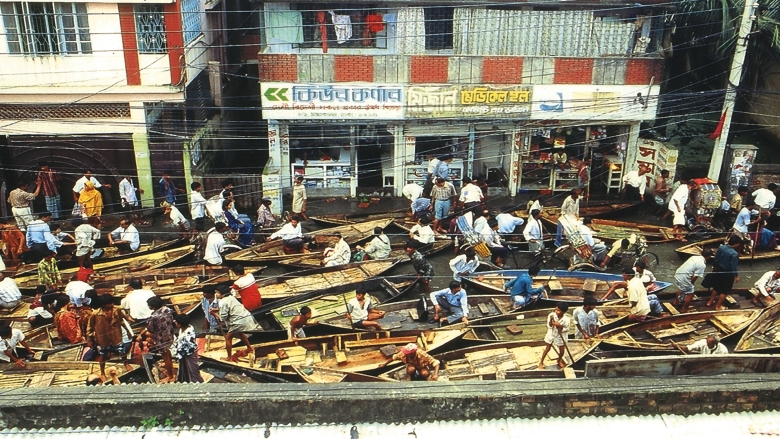Dhaka - a hotspot for Urban Flooding
Bangladesh’s capital Dhaka suffers floods and waterlogging almost every monsoon. With each intense rainfall that batters the city, lives of the residents, especially the slum dwellers are disrupted. In recent years, rapid indiscriminate urbanization and the gradual filling up of low lying flood plains, rivers and canals has further worsened the problem.
Climate change may aggravate waterlogging
The Fifth Assessment Report of the Intergovernmental Panel of Climate Change, predicts longer monsoon and more erratic rainfall over the Ganga-Brahmaputra-Meghna basin. With frequent and intense rainfall, climate change alongside other non-climatic factors such as increase in population density, unplanned urbanization and lack of public utilities and services is likely to further aggravate waterlogging.
Enhancing disaster resilience and preparing for climate-related risks is a daunting task
Dhaka needs climate-smart policies and investments to improve its resilience to intense rainfall and to prepare for climate change. Policy makers need a better understanding of adaptation costs and the potential damages resulting from climate change to formulate effective adaptation policies. A new World Bank book ‘Urban Flooding of Greater Dhaka in a Changing Climate: Building Local Resilience to Disaster Risk’ and a new report ‘Climate and Disaster Resilience of Greater Dhaka Area: A Micro Level Analysis’ will help policy makers prioritize interventions to cope with urban flooding and climate change.
Dhaka’s infrastructure and facilities vary significantly in regards to resilience to floods and waterlogging. The study assessed the cities local preparedness to urban flooding at ward level measuring Climate Disaster Resilience Index (CDRI). It conducted hydrological modeling to estimate depth and duration of waterlogging from intense rainfall events despite of climate change and developed a list of options with cost estimates for each area to mitigate inundation. It was estimated that damage from urban flooding can be avoided if the recommended investments are made.
The study addressed the issue from both current and future climate perspectives. Dhaka experienced 341mm rainfall in 24 hours in September 2004; and this historic intense rainfall was taken as the current climate baseline in the analysis. For the future, the study considered a 16 percent increase in extreme rainfall in a changing climate by 2050.
How well is Greater Dhaka prepared?
The overall CDRI for Greater Dhaka is 2.35 in a five-point scale, indicating a modest level of resilience. However, the CDRI of DND and Kallyanpur area fall below the city average. Dhaka can enhance disaster resilience by improving governance, implementing the Crisis Management Framework, and mainstreaming disaster risk reduction and climate change adaptation.
Climate-smart policies and higher investment needed
Even without climate change, increased population density will make Dhaka more vulnerable to floods and waterlogging. The study estimates if an intense rainfall, like the rainfall of September 2004 (341mm in 24 hours), occurs in 2050, then Dhaka will need Taka 270 crores (Taka 2.7 billion) investment in storm water drainage pumps, drainage pipe clearing etc. to reduce inundation depth to 4-8 inches in every neighborhood within twelve hours. This investment will be necessary in addition to the improvements in the drainage infrastructure already planned and proposed in RAJUK’s Detailed Area Plan, Sewerage Master Plan of Dhaka WASA and Narayanganj City Corporation’s Concept Vision Plan. The Dhaka WASA’s Strom Water Drainage Maser Plan alone proposes an investment of Taka 16,000 crore.
Climate change will further increase vulnerability of Dhaka to flooding and waterlogging. The study calculates an incremental cost of adaptation for Dhaka to climate change by 2050 is about Taka 130 crores.
How important is further investments in the storm drainage infrastructure?
Even without climate change, likely damage from waterlogging in Dhaka by 2050 is Taka 11,000 crores. In a changing climate with more intense rainfalls, the loss will be Taka 139,000 crores between 2014 and 2050. These damages can be reduced significantly to Taka 3,700 crores, if Taka 270 crores investment is made. The amount Taka 270 crores is equivalent to only 0.35 percent of the government’s annual development budget expenditure for 2014-2015.
The Way forward
Dhaka is still not prepared for an intense rainfall event similar to that of September 2004. The city authorities can address the existing deficits in infrastructure by dealing with historic intense rainfall events. Closing the gap in infrastructure to meet historic climate-related risks will provide a foundation to build additional measures to mitigate climate risks in Dhaka. Mainstreaming disaster risk reduction and climate change adaptations in planning will help the city become a vibrant growth center.
The study is funded by the Bangladesh Climate Change Resilience Fund (BCCRF), a multi-donor trust fund, administered by the World Bank.

